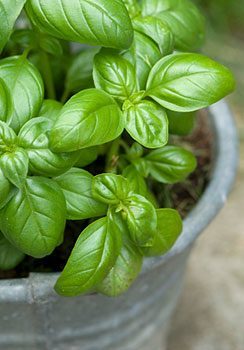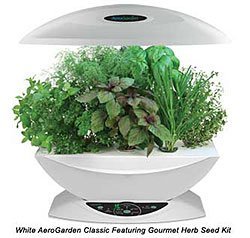Growing herbs in containers is easiest way to have kitchen herbs at hand for snipping as you’re cooking. Spreading herbs such as mint are also easier to control when you grow them in pots.
Containers also make it easy to grow herbs like rosemary, which is not hardy in colder regions. If it lives in a pot, you can just take the plant inside to weather the cold.
What herbs in containers need to thrive

Herbs in containers: basil grows well
Full sun: 6 hours minimum.
Big enough containers: At least 10 to 12 inches (25 to 30 cm) deep with one or more holes for good drainage. Larger containers such as half barrels give you enough room to grow several kitchen herbs in one space.
Soil-less potting mix: Don’t use garden soil, although you can add a little compost or bagged manure to enrich potting soil.
Watering: How much to water depends on the weather, the plants and the size and type of pot. Terra cotta containers dry out quickly and usually need daily watering high summer. The larger the pot, the easier it is to keep moist.
Fertilizing: Like all container plants, herbs need fertilizer. Slow release fertilizer pellets added to the top layer of soil at planting are easy: they feed constantly over the growing season. Or give soluble fertilizer with watering once a week.
Growing herbs in containers indoors
Although it’s tempting to take your herb plants indoors for winter, especially perennial types, unfortunately, in northern regions even a south-facing window gets a lot less sun in winter than the plants need.
It helps to remember that most culinary herbs thrive in the hot and sunny Mediterranean, and that they do best in such conditions.
Mediterranean winters are moist, but central heating keeps the air very dry, which is another disadvantage.
Areogarden – a new way to grow herbs indoors

Herbs need lots of light, at least 6 hours a day
If you’re really serious about having a herb garden indoors and you don’t have a south-facing window, an AeroGarden might be just the thing for you.
It comes with it own grow light, and works by suspending plant containers in a tank of water and flowing water to them by means of a small pump.
You start the plants from seeds (which are supplied). It’s basically hydroponic gardening: no soil, just water, air, and nutrients.
For success with herbs in containers indoors
- A sunny south-facing window, plus a florescent grow-light for extra brightness.
- Growth will slow down, so harvest small amounts only (if your goal is to keep plants for next year); or continue to harvest until you use leaves up and then discard plant.
- Water when potting soil feels dry to touch. Avoid overwatering, but mist around the plants often.
- For best winter survival of rosemary, move plant into shadier spot outdoors in early fall to acclimatize to lower light.
- Indoors, keep pots in a cool bright window with a florescent grow light. A bright, unheated sun porch is ideal, as long as temperatures don’t dip below 21ºF (-6ºC).
More herb growing tips
Richters Herbs: Plants, Seeds, More!
How to grow vegetables in containers




